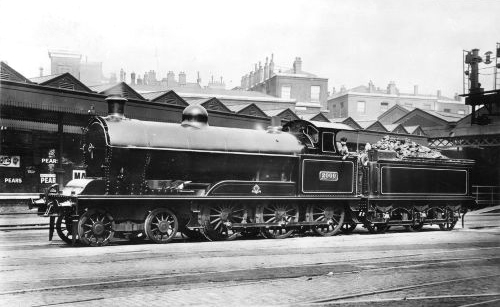LNWR 19in Express Goods Class on:
[Wikipedia]
[Google]
[Amazon]
 The
The
 The
The London and North Western Railway
The London and North Western Railway (LNWR, L&NWR) was a British railway company between 1846 and 1922. In the late 19th century, the LNWR was the largest joint stock company in the world.
Dubbed the "Premier Line", the LNWR's main line connec ...
(LNWR) 19in Express Goods Class, otherwise known as the Experiment Goods Class was a class of 4-6-0
A 4-6-0 steam locomotive, under the Whyte notation for the classification of steam locomotives by wheel arrangement, has four leading wheels on two axles in a leading bogie and six powered and coupled driving wheels on three axles with the abs ...
steam locomotive
A steam locomotive is a locomotive that provides the force to move itself and other vehicles by means of the expansion of steam. It is fuelled by burning combustible material (usually coal, Fuel oil, oil or, rarely, Wood fuel, wood) to heat ...
s. They were essentially a smaller wheeled version of the Whale's Experiment Class and were an early attempt at a mixed traffic engine.
Career
The engine was developed under the direction ofGeorge Whale
George Whale (7 December 1842 – 7 March 1910) was an English locomotive engineer who was born in Bocking, Essex, and educated in Lewisham, London. He worked for the London and North Western Railway (LNWR).
Career
In 1858 he entered the LNWR's ...
, the then Chief mechanical engineer
Chief mechanical engineer and locomotive superintendent are titles applied by British, Australian, and New Zealand railway companies to the person ultimately responsible to the board of the company for the building and maintaining of the locomotive ...
of the LNWR. The goal was to create a powerful locomotive for express freight service that would also be suitable for passenger trains. Following the great success of the Precursor Class and the Experiment Class for passenger service, Whale designed a freight or mixed-traffic version of the Experiment Class in 1906, known as the 19in Express Goods.
Crewe built 170 engines between 1906 and 1909. The LNWR reused numbers from withdrawn locomotives, so the numbering was haphazard.
The locomotives were most useful engines and, in addition to their primary role in express freight service, were also employed on passenger excursion trains. On occasion, they served as pilot engines for heavy express services on the West Coast Main Line
The West Coast Main Line (WCML) is one of the most important railway corridors in the United Kingdom, connecting the major cities of London and Glasgow with branches to Birmingham, Manchester, Liverpool and Edinburgh. It is one of the busiest ...
(WCML), particularly on the challenging section between Carlisle
Carlisle ( , ; from ) is a city in the Cumberland district of Cumbria, England.
Carlisle's early history is marked by the establishment of a settlement called Luguvalium to serve forts along Hadrian's Wall in Roman Britain. Due to its pro ...
and Shap Summit
Shap Summit refers to three different route summits in close proximity, of the A6 road (England), A6 road, M6 motorway and the highest point of the West Coast Main Line railway in England, near to the Cumbria village of Shap in North West England, ...
.
All passed onto LMS ownership in 1923. The LMS gave them the power classification
A number of different numbering and classification schemes were used for the locomotives owned by the London, Midland and Scottish Railway (LMS) and its constituent companies.
The LMS, formed on 1 January 1923 from many smaller companies include ...
4F. The LMS renumbered them into the more logical series 8700–8869. Withdrawals started in 1931. British Railways
British Railways (BR), which from 1965 traded as British Rail, was a state-owned company that operated most rail transport in Great Britain from 1948 to 1997. Originally a trading brand of the Railway Executive of the British Transport Commis ...
acquired three 8801/24/34 in 1948, but all were withdrawn by 1950 before they could receive their allocated numbers 48801/24/34. None were preserved.
References
External links
* * {{LNWR Locomotives Experiment Goods 4-6-0 locomotives 2′C n2 locomotives Railway locomotives introduced in 1906 Scrapped locomotives Standard-gauge steam locomotives of Great Britain